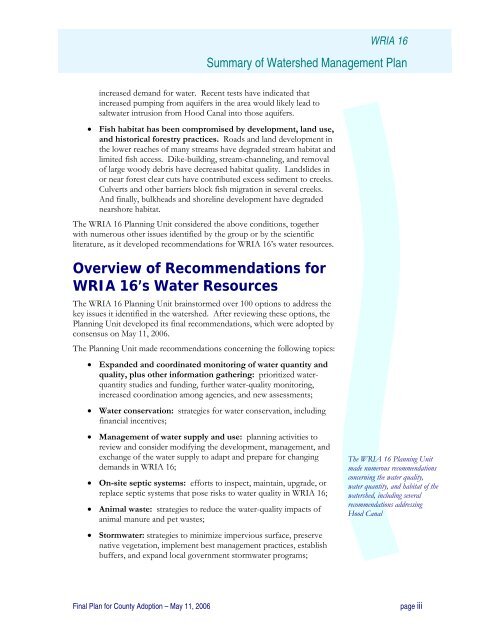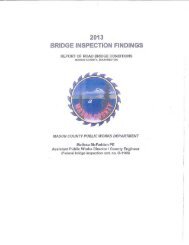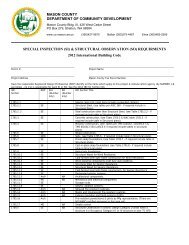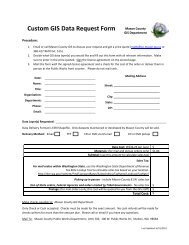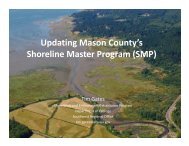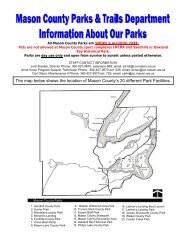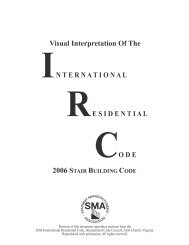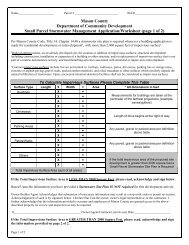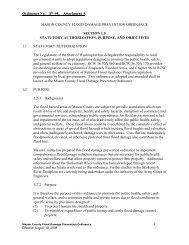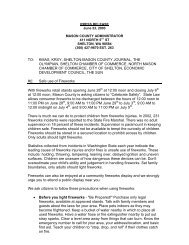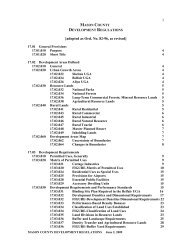Watershed Management Plan - Mason County
Watershed Management Plan - Mason County
Watershed Management Plan - Mason County
You also want an ePaper? Increase the reach of your titles
YUMPU automatically turns print PDFs into web optimized ePapers that Google loves.
WRIA 16<br />
Summary of <strong>Watershed</strong> <strong>Management</strong> <strong>Plan</strong><br />
increased demand for water. Recent tests have indicated that<br />
increased pumping from aquifers in the area would likely lead to<br />
saltwater intrusion from Hood Canal into those aquifers.<br />
• Fish habitat has been compromised by development, land use,<br />
and historical forestry practices. Roads and land development in<br />
the lower reaches of many streams have degraded stream habitat and<br />
limited fish access. Dike-building, stream-channeling, and removal<br />
of large woody debris have decreased habitat quality. Landslides in<br />
or near forest clear cuts have contributed excess sediment to creeks.<br />
Culverts and other barriers block fish migration in several creeks.<br />
And finally, bulkheads and shoreline development have degraded<br />
nearshore habitat.<br />
The WRIA 16 <strong>Plan</strong>ning Unit considered the above conditions, together<br />
with numerous other issues identified by the group or by the scientific<br />
literature, as it developed recommendations for WRIA 16’s water resources.<br />
Overview of Recommendations for<br />
WRIA 16’s Water Resources<br />
The WRIA 16 <strong>Plan</strong>ning Unit brainstormed over 100 options to address the<br />
key issues it identified in the watershed. After reviewing these options, the<br />
<strong>Plan</strong>ning Unit developed its final recommendations, which were adopted by<br />
consensus on May 11, 2006.<br />
The <strong>Plan</strong>ning Unit made recommendations concerning the following topics:<br />
• Expanded and coordinated monitoring of water quantity and<br />
quality, plus other information gathering: prioritized waterquantity<br />
studies and funding, further water-quality monitoring,<br />
increased coordination among agencies, and new assessments;<br />
• Water conservation: strategies for water conservation, including<br />
financial incentives;<br />
• <strong>Management</strong> of water supply and use: planning activities to<br />
review and consider modifying the development, management, and<br />
exchange of the water supply to adapt and prepare for changing<br />
demands in WRIA 16;<br />
• On-site septic systems: efforts to inspect, maintain, upgrade, or<br />
replace septic systems that pose risks to water quality in WRIA 16;<br />
• Animal waste: strategies to reduce the water-quality impacts of<br />
animal manure and pet wastes;<br />
• Stormwater: strategies to minimize impervious surface, preserve<br />
native vegetation, implement best management practices, establish<br />
buffers, and expand local government stormwater programs;<br />
The WRIA 16 <strong>Plan</strong>ning Unit<br />
made numerous recommendations<br />
concerning the water quality,<br />
water quantity, and habitat of the<br />
watershed, including several<br />
recommendations addressing<br />
Hood Canal<br />
Final <strong>Plan</strong> for <strong>County</strong> Adoption – May 11, 2006<br />
page iii


